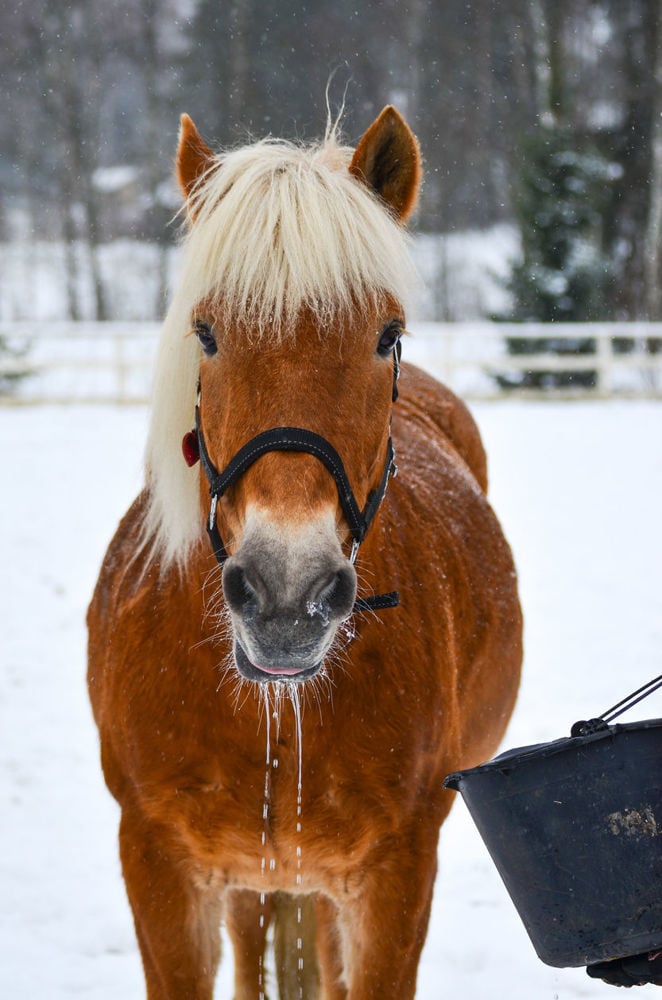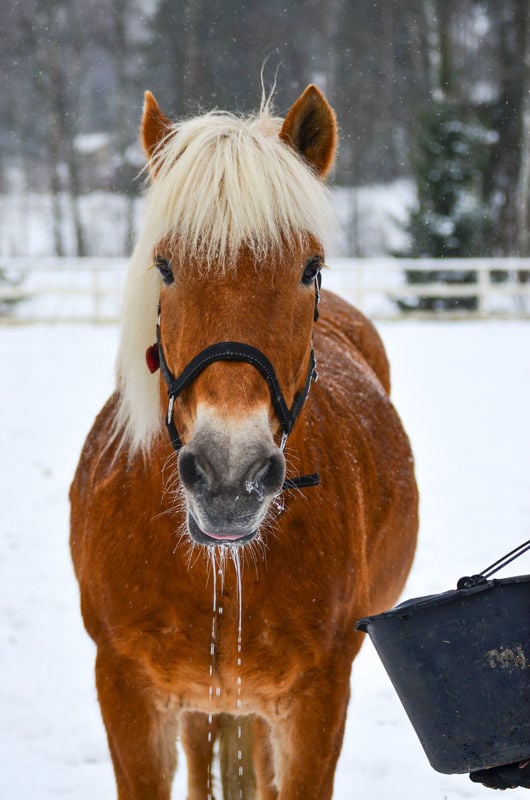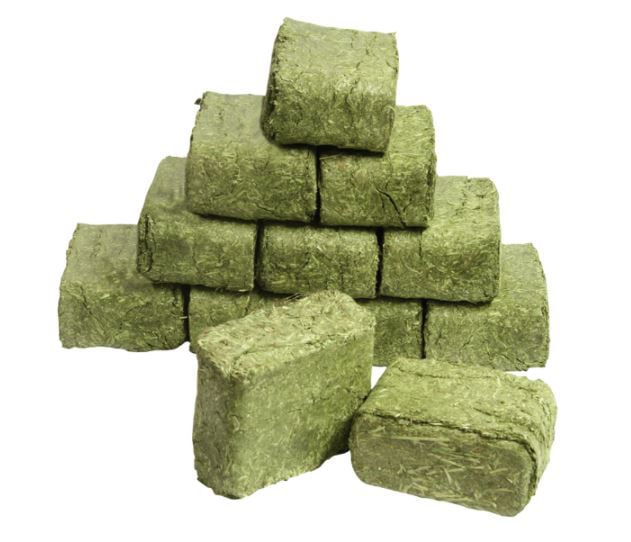Rebecca Allan, Assistant Nutritionist
Winter is a dark and cold time of year where keeping yourself and your horses warm becomes the main priority, probably the last thing on your mind is that your horse could become dehydrated. Horses lose water from their body through faeces, urine, sweat and even through exhaling air, especially in winter when the dry cold air increases water loss from the respiratory tract and lungs. Sure, your horse does not sweat as much in the winter as in the summer, but this does not mean their fluid requirements decrease because temperatures drop. The accepted water requirement for horses is around 60ml/kg per day. Thus, in practical terms, an average horse (500kg) would require approximately 30L of water per day as a minimum requirement.
In the summer, turnout is more common and grass consumption is more readily available to horses. Naturally, grass has moisture levels of approximately 60-80% which contributes to your horse´s daily water intake. In contrast, in winter, hay and grain feeds are fed more abundantly due to reduced grass availability. These feedstuffs contain less than 15% moisture and poorly contribute to the horse´s daily water intake. This highlights the importance of water consumption during the winter months as after all, water accounts for 61-72% of a mature horse´s body weight.
Water is also necessary for maintaining moisture levels in the horse´s gastrointestinal system. If adequate water levels are not met this increases the risk of impaction colic or intestinal blockage. You may assume a horse will drink water when it requires it, however horses may tend to drink less in the winter months and horse owners are wise to encourage horses to drink. As the famous phrase says “You can lead a horse to water, but you can´t make it drink” this is exactly true, you can´t forcefully make your horse drink however, there are ways to encourage their water intake. I have therefore put together a few top tips to encourage water consumption for your horses...

Figure 1: Keeping horses hydrated is essential during winter.
WARM WATER
A trial compared the ab libitum consumption of ambient near-freezing water (ranged from 0°C to 1°C) and warm water (46°C to 49°C when provided) for 14 ponies. The study concluded that on average, 40% of the ponies drank more warm water compared to ambient, near-freezing water. Warm water refills occurred at 46°C to 49°C, however, most consumption happened when the water was at 20°C to 35°C. Based on this study, providing warm water for horses may encourage them to drink and maintain hydration levels.
Some yards can provide warm water from insulated taps, however not all yards provide these facilities. An alternative way to provide warm water is by boiling a kettle and mixing it with cold water. However, it would be recommended to use a thermometer to check the water temperature before providing it to horses. Alternatively, on the market nowadays, are heated buckets and bucket cosies which can heat the water in the buckets and maintain the waters warmth for 6 -12hr on average. Although this does incur a cost it is a useful viable option and is more practical in the long run.
As temperatures drop, water may freeze stopping horses drinking due to thick layers of ice. By providing warm water you are minimising the risk of freezing occurring which may save you the hassle of breaking up icy water buckets.
Nevertheless, it can be greatly understood that although warm water works wonders to encourage horses to drink it may not be practical for every horse owner/ yard therefore there are other alternatives. Introducing a flavour into horses´ water may also encourage them to drink.
FLAVOURED WATER
Another study performed a study on 40 hospitalised horses to see if their voluntary water intake increased by flavoured water. Water was flavoured with either commercial concentrated sweet feed, peppermint extract, or apple electrolytes. Each horse had access to one bucket of flavoured water and one bucket of plain water (18.9L per bucket) and the buckets were emptied and refilled at least once every 24hr. This study was performed during a period of 72hr.
The amounts of additive per water bucket where the following:
- Sweet feed (0.125kg per 18.9L)
- Peppermint extract (10mL per 18.9L)
- Apple Electrolyte (28.41mL per 18.9L)
The results strongly supported the increased water consumption for sweet feed flavoured water in comparison to unflavoured water. Interestingly there was also strong evidence supporting the consumption of unflavoured water over water flavoured with peppermint extract or apple electrolytes. The researchers of this study also pointed out that the levels of the additive flavours did not vary throughout to study so it is thought that increasing or decreasing additive levels may also encourage flavoured water consumption.
Based on this study, it can be concluded that sweet feed flavoured water increased voluntary water consumption. Therefore, flavouring water with sweet feed or other sweet, flavoured alternatives such as molasses may show positive results on your horse’s water consumption. Interestingly, apple cider vinegar, a supplement fed to many horses, is another option for flavoured water. Although the vinegary taste might sound repelling to us, it is thought horses can find the taste appealing especially if it is already included in their diets. Nevertheless, every horse is an individual and will have their own preferences so when choosing a water additive, it might be a process of trial and error until you figure out the one your horse enjoys the most. Furthermore, always provide a bucket of unflavoured water alongside the flavoured water to give your horse the freedom of choice.
SOAKING FIBRE BLOCKS AND MASHES
For horses to stay warm in winter, forage consumption must increase. Mashes high in fibre are ideal as it increases forage consumption and aids water intake. Such options are Timothy grass blocks and Fibre blocks which provide an alternative source of forage which can be fed dry or soaked, which in winter would be the preferred option to encourage water intake. The Fibre blocks are made from 50% Alfalfa grass and 50% dust-extracted Oat straw. They are low in sugar and starch levels making them ideal for those equines on restricted sugar diets. Alternatively, the Timothy Grass Blocks provides your horse with the nutritional value of fresh 100% Timothy grass. Therefore, supplying your horse with increased fibre intake whilst tasting like fresh grass which your horse may appreciate if their turnout has been restricted.
Soaking the blocks with warm water would be a win-win situation as it would provide warmth, encourage water intake, and forage consumption, all three key points of a winter feeding routine. Another benefit to soaking blocks is to ease the digestive and chewing process for older horses or those with poor teeth.
Alternatively, there are many other commercial mashes on the market such as oat bran and sugar beet, although please see feeding recommendations of the products before administering to your horse.
CLEANLINESS
Finally, an important general point to mention is that your horse´s water buckets or feeders should always be clean. Cleanliness is the baseline of water intake for your horses, regardless of if your water is warmed or flavoured, it must be clean and fresh first.
SUMMARY
In conclusion, keeping your horses hydrated in winter is essential for their health and wellbeing. The three main ways to encourage your horse to consume water are by providing a source of warm water, flavoured water (recommended of a sweet nature), or by feeding soaked fibre blocks and mashes. Nevertheless, always remember that the source of water must always be clean.
Hopefully, these alternatives have been interesting and useful and will support your horse’s hydration levels throughout the winter and ease the worry of dehydration from horse owners and yards.
If you would like any advice, please contact our Equine Nutrition Team who would be happy to help you. You can email [email protected] or call our freephone advice line on 0800 585525.



